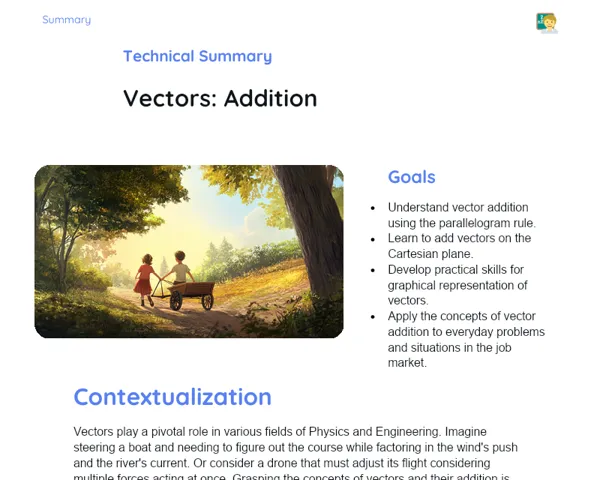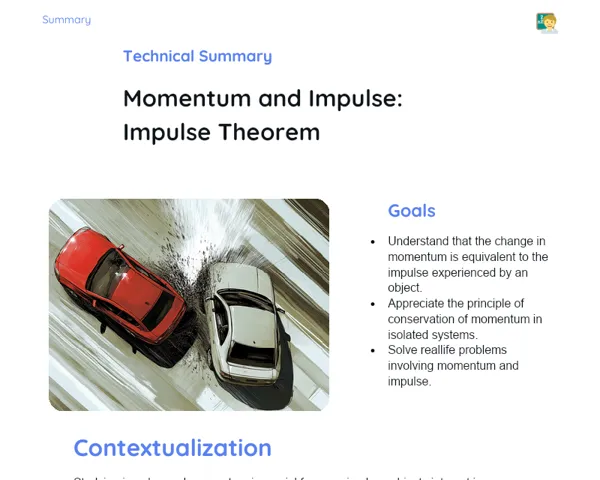Socioemotional Summary Conclusion
Goals
1. Understand the principles of conservation of linear momentum and their application in two-dimensional collisions.
2. Comprehend the concept of the coefficient of restitution and its relevance in collision dynamics.
3. Apply problem-solving skills to calculate the outcomes of collisions in two-dimensional scenarios.
Contextualization
Have you ever pondered how billiard balls behave when they collide? 🤔 It's not merely a game of chance, but the laws of physics at play! Grasping how to calculate these interactions can enhance your understanding of everything from road accidents to the dynamics of sports! 🌟
Exercising Your Knowledge
Impulse
Impulse is a vector quantity that quantifies the force acting on an object over a certain time period. It's essential for understanding how an object's momentum changes, especially during collisions. By calculating impulse, we can ascertain the change in an object's velocity post-collision. This not only deepens our theoretical approach but also aids in anticipating and managing real-life situations where forces and movements come into play.
-
Definition: Impulse equals the product of force (F) and the time interval (Δt) over which the force acts. Mathematically, it can be represented as I = F * Δt.
-
Importance: Grasping impulse helps anticipate an object's behavior after a collision, crucial in scenarios ranging from sports to road safety.
-
Socio-emotional Aspect: Think about times when you've felt compelled by strong emotions and how regulating these emotional 'impulses' can lead to more rational and safer choices.
Momentum
Momentum, or linear momentum, measures an object's motion by considering both its mass and velocity. This metric is vital for understanding interactions during collisions and serves as a robust tool in solving physics problems. Mastering the conservation of momentum in isolated systems is a fundamental step in the study of collisions.
-
Definition: Momentum (p) is calculated as the product of an object's mass (m) and its velocity (v). Simplified, it is expressed as: p = m * v.
-
Conservation of Momentum: In an isolated system, the total momentum before and after a collision remains unchanged, as per the Law of Conservation of Momentum.
-
Socio-emotional Aspect: Much like momentum being conserved, our emotions can also 'stay' and influence various facets of our lives. Recognizing and managing these emotions enables us to handle conflicting scenarios proficiently.
Coefficient of Restitution
The coefficient of restitution (e) gauges how much objects 'bounce back' following a collision. This value ranges from 0 to 1: 0 implies a perfectly inelastic collision (the objects stick together post-collision), whereas 1 signifies a perfectly elastic collision (the objects separate without any loss of kinetic energy). Understanding this coefficient is critical for analyzing the behavior of objects after collisions.
-
Definition: The coefficient of restitution represents the ratio of the relative separation speed to the relative approach speed of the objects before and after the collision.
-
Importance: It is crucial in determining the collision type and predicting the subsequent behavior of the objects involved, being essential for mechanics and practical applications like vehicle design and safety.
-
Socio-emotional Aspect: Reflect on instances where you needed to 'bounce back' after facing challenges, and consider how socio-emotional skills can assist in recovery and moving forward.
Key Terms
-
Impulse: The change in momentum that arises from a force applied over a duration.
-
Momentum: The product of an object's mass and velocity, symbolizing the object's 'motion.'
-
Law of Conservation of Momentum: A principle asserting that in an isolated system, the total momentum remains unchanged.
-
Coefficient of Restitution: A measure of the 'bounciness' of collisions, ranging from 0 (inelastic collision) to 1 (elastic collision).
For Reflection
-
How do you cope with emotional 'impulses' in stressful settings? What strategies do you employ to stay calm and make logical decisions?
-
As momentum is conserved in isolated systems, are you aware that your emotions can have a lasting effect on different aspects of your life? How do you manage them?
-
In what contexts do you sense the need to 'bounce back', similar to an elastic collision? What socio-emotional skills can you hone to tackle such challenges better?
Important Conclusions
-
Grasping impulse facilitates the calculation of momentum changes in objects after collisions.
-
Momentum is essential for describing an object's motion, considering its mass and velocity.
-
The Law of Conservation of Momentum demonstrates that in an isolated system, the total momentum is constant even post-collision.
-
The coefficient of restitution deepens our understanding of the 'elasticity' of collisions, forecasting the behaviors of bodies after impact.
-
Studying two-dimensional collisions not only equips us to address academic challenges but also aids in making informed decisions in everyday scenarios, like road safety and sports.
Impacts on Society
Exploring impulse and momentum significantly influences various sectors of our society. For instance, engineers utilize these principles to design safer and more efficient vehicles, analysing how forces act during crashes to mitigate damage and save lives. This knowledge plays a vital role in crash tests, enhancing the safety of the vehicles we rely on daily, ultimately improving passenger and driver safety. Additionally, an understanding of these concepts in sports fosters more effective strategies and better performance. Athletes in billiards, hockey, and even football leverage collision knowledge to predict ball movement after impact. This grasp not only enriches spectator experience but also empowers athletes to refine their skills and strategize effectively.
Dealing with Emotions
To apply the RULER method, start by recognizing the emotions that surface when grappling with a challenging topic, like the physics of collisions. Next, understand the triggers behind those feelings – was it the complexity of the problem or the pressure to resolve it swiftly? Label these feelings accurately: frustration, anxiety, excitement, and so on. Articulate these emotions by jotting them down or discussing them with a classmate. Finally, regulate your feelings: take a deep breath, step away momentarily, and approach the problem with a fresh mindset. This exercise will enhance your emotional management and foster a positive attitude toward tackling complex subjects.
Study Tips
-
Form small study groups for discussions on concepts and problem-solving related to two-dimensional collisions. Collaborative study provides fresh perspectives and solutions.
-
Utilize visual aids like explanatory videos and collision simulations. These resources can simplify the understanding of abstract physics concepts, making studying more interactive and engaging.
-
Regularly practice physics problems and seek real-life applications, such as observing collisions during sports events. This relevance enhances the learning experience and keeps it interesting.



